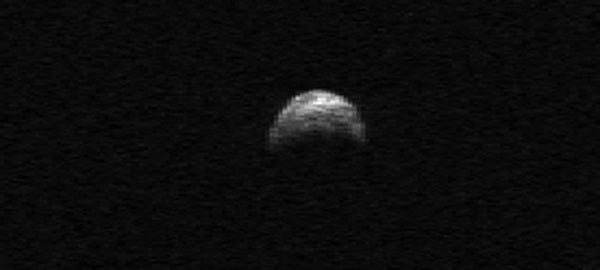NASA scientists are tracking asteroid 2005 YU55 with antennas of the agency’s Deep Space Network at Goldstone, California, as the space rock safely flies past Earth, slightly closer than the Moon’s orbit, November 8. Scientists are treating the flyby of the 1,300-foot-wide (400 meters) asteroid as a science target of opportunity, allowing instruments on “spacecraft Earth” to scan it during the close pass.
Tracking the aircraft-carrier-sized asteroid began at 9:30 a.m. PDT November 4, using the massive 230-foot (70m) Deep Space Network antenna. The Goldstone facility is continuing to track the asteroid for at least four hours each day from November 6 through November 10. Radar observations from the Arecibo Planetary Radar Facility in Puerto Rico will begin November 8, the same day the asteroid will make its closest approach to Earth at 3:28 p.m. PST.
The trajectory of asteroid 2005 YU55 is well understood. At the point of closest approach, it will be no closer than 201,700 miles (324,600 kilometers), or 0.85 the distance from the Moon to Earth. The gravitational influence of the asteroid will have no detectable effect on anything here on Earth, including our planet’s tides or tectonic plates. Although 2005 YU55 is in an orbit that regularly brings it to the vicinity of Earth (and Venus and Mars), the 2011 encounter with Earth is the closest this space rock has come for at least the past 200 years.
During tracking, scientists will use the Goldstone and Arecibo antennas to bounce radio waves off the space rock. Radar echoes returned from 2005 YU55 will be collected and analyzed. NASA scientists hope to obtain images of the asteroid from Goldstone as fine as about 7 feet (2m) per pixel. This should reveal a wealth of detail about the asteroid’s surface features, shape, dimensions, and other physical properties.
Arecibo radar observations of asteroid 2005 YU55 made in 2010 show it to be approximately spherical in shape. It is slowly spinning, with a rotation period of about 18 hours. The asteroid’s surface is darker than charcoal at optical wavelengths. Amateur astronomers who want to get a glimpse at YU55 will need a telescope with an aperture of 6 inches or larger.
The last time a space rock as big came this close to Earth was in 1976, although astronomers did not know about the flyby at the time. The next known approach of an asteroid this large will be in 2028.
You can find more information about observing the magnitude 10 asteroid at the Minor Planet Center.
NASA scientists are tracking asteroid 2005 YU55 with antennas of the agency’s Deep Space Network at Goldstone, California, as the space rock safely flies past Earth, slightly closer than the Moon’s orbit, November 8. Scientists are treating the flyby of the 1,300-foot-wide (400 meters) asteroid as a science target of opportunity, allowing instruments on “spacecraft Earth” to scan it during the close pass.
Tracking the aircraft-carrier-sized asteroid began at 9:30 a.m. PDT November 4, using the massive 230-foot (70m) Deep Space Network antenna. The Goldstone facility is continuing to track the asteroid for at least four hours each day from November 6 through November 10. Radar observations from the Arecibo Planetary Radar Facility in Puerto Rico will begin November 8, the same day the asteroid will make its closest approach to Earth at 3:28 p.m. PST.
The trajectory of asteroid 2005 YU55 is well understood. At the point of closest approach, it will be no closer than 201,700 miles (324,600 kilometers), or 0.85 the distance from the Moon to Earth. The gravitational influence of the asteroid will have no detectable effect on anything here on Earth, including our planet’s tides or tectonic plates. Although 2005 YU55 is in an orbit that regularly brings it to the vicinity of Earth (and Venus and Mars), the 2011 encounter with Earth is the closest this space rock has come for at least the past 200 years.
During tracking, scientists will use the Goldstone and Arecibo antennas to bounce radio waves off the space rock. Radar echoes returned from 2005 YU55 will be collected and analyzed. NASA scientists hope to obtain images of the asteroid from Goldstone as fine as about 7 feet (2m) per pixel. This should reveal a wealth of detail about the asteroid’s surface features, shape, dimensions, and other physical properties.
Arecibo radar observations of asteroid 2005 YU55 made in 2010 show it to be approximately spherical in shape. It is slowly spinning, with a rotation period of about 18 hours. The asteroid’s surface is darker than charcoal at optical wavelengths. Amateur astronomers who want to get a glimpse at YU55 will need a telescope with an aperture of 6 inches or larger.
The last time a space rock as big came this close to Earth was in 1976, although astronomers did not know about the flyby at the time. The next known approach of an asteroid this large will be in 2028.
You can find more information about observing the magnitude 10 asteroid at the Minor Planet Center.










